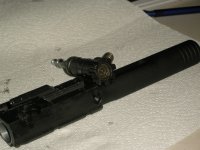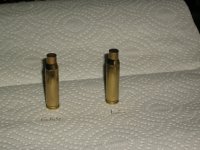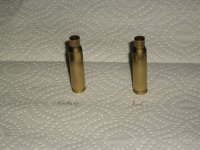I was testing some loads in my M&P10 yesterday and near the end of my session I noticed a fired case with no primer.
I looked in the receiver because that is where I had heard of loose primers causing problems but there was nothing and the gun worked fine.
I shot my last group of loads over the chrono and at the paper and then decided to expend a few at my steel. I had fired 45 rounds by now of varying powder and bullet weights.
The rounds I had left were some of the ones I had made for fouling rounds with 50.8gr CFE under a 150 BTFMJ Hornady bulk projectile. All the loads had Winchester WLR for primers. All primers inserted with the Lee tool.
I started the session with ten of these rounds and they ran great.
At the end however after about 5 rounds the gun locked up tight, not in battery because I pressed the trigger, got a click but no bang.
I got up and looked at the cases on the ground and found a pierced primer.
I butt-stroked the gun to eject the stuck round and tried again, thinking I had done a bad job sizing. No, stuck again.
I removed the mag and round, disassembled the gun wiped everything, saw a very little piece of brass (or primer) put it back together and tried again.
2 rounds fired and the gun locked again. Two more pierced primers. This time I had to use a range rod to force the bolt back but it went fairly easily for all that.
More little pieces.
I stopped for the day and when I got home I disassembled everything and cleaned everything. Found a little more chips but not many. No marks of dings on the firing pin. Firing pin hole looks good to me.
Does any of this sound afmilar to anyone?
Does anyone have an idea of what I should do before firing it again?
TIA, Lief
I looked in the receiver because that is where I had heard of loose primers causing problems but there was nothing and the gun worked fine.
I shot my last group of loads over the chrono and at the paper and then decided to expend a few at my steel. I had fired 45 rounds by now of varying powder and bullet weights.
The rounds I had left were some of the ones I had made for fouling rounds with 50.8gr CFE under a 150 BTFMJ Hornady bulk projectile. All the loads had Winchester WLR for primers. All primers inserted with the Lee tool.
I started the session with ten of these rounds and they ran great.
At the end however after about 5 rounds the gun locked up tight, not in battery because I pressed the trigger, got a click but no bang.
I got up and looked at the cases on the ground and found a pierced primer.
I butt-stroked the gun to eject the stuck round and tried again, thinking I had done a bad job sizing. No, stuck again.
I removed the mag and round, disassembled the gun wiped everything, saw a very little piece of brass (or primer) put it back together and tried again.
2 rounds fired and the gun locked again. Two more pierced primers. This time I had to use a range rod to force the bolt back but it went fairly easily for all that.
More little pieces.
I stopped for the day and when I got home I disassembled everything and cleaned everything. Found a little more chips but not many. No marks of dings on the firing pin. Firing pin hole looks good to me.
Does any of this sound afmilar to anyone?
Does anyone have an idea of what I should do before firing it again?
TIA, Lief




